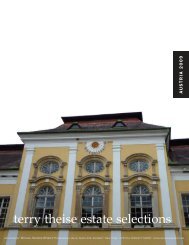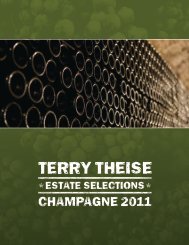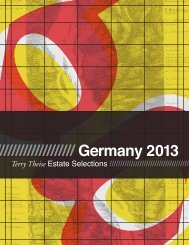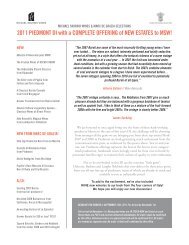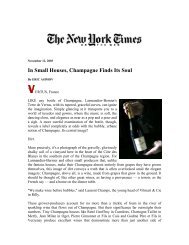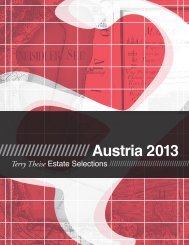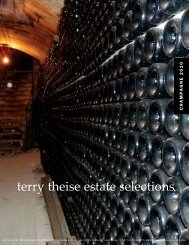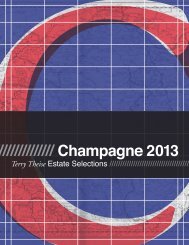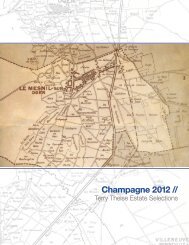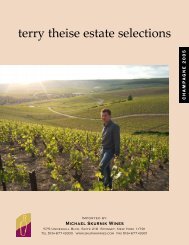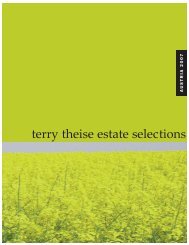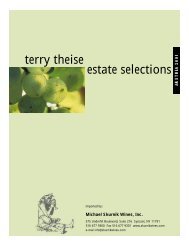German Catalog 2006 USE THIS ONE.qxp - Michael Skurnik Wines
German Catalog 2006 USE THIS ONE.qxp - Michael Skurnik Wines
German Catalog 2006 USE THIS ONE.qxp - Michael Skurnik Wines
Create successful ePaper yourself
Turn your PDF publications into a flip-book with our unique Google optimized e-Paper software.
toni jost<br />
mittelrhein • bacharach<br />
Jost’s wines have been famously tardy since Peter began his regime of long lees-contact, and I<br />
have sometimes underrated them out of the gate-I and other tasters also. They have appeared to<br />
slip down a notch from the elite position they held. I had hoped the 2003s would arrest this<br />
trend, but there was a strange Kabinett which evolved odd beery notes after bottling. Josts are<br />
aware of this, but disagree with my intuition it has something to do with lees. In any event,<br />
2005was wonderful, and I hope it will remain wonderful in bottle.<br />
Want to hear a story of fortitude? Peter Jost broke his leg in the vineyards just three days<br />
before the harvest one year. He was in utter denial. This simply could not be. He didn’t go in for<br />
X-rays for three days, and when he did he was told “your leg is broken and you’ll be laid up for<br />
about six weeks.” “Um, I don’t think so!” After three<br />
weeks hobbling around on crutches, includingpicking<br />
grapes in vineyards as steep as 60 degrees, his Doctor<br />
told him “Look, if you don’t get off your feet we’ll put<br />
you on your back!”<br />
The solution? A WHEELCHAIR! “I rolled through the<br />
cellar in my wheelchair and made my wines,” said Peter.<br />
This is an estate with the lion’s share of a single vineyard,<br />
with which they are identified, in this case the<br />
BACHARACHER HAHN. There are a few other parcels<br />
also (along with some Rheingauers), but Jost and Hahn<br />
are inextricably linked. I’ve looked at Hahn from all sides<br />
now; from across the river (where it looks impossibly<br />
steep), from immediately below it, from above it, within<br />
it, and any way you slice it, this is one special site; steep<br />
goes without saying, perfect exposure, large enough to<br />
allow selective harvesting. One cannot tell anymore<br />
whether its exuberant glory of fruit is innate, as there<br />
aren’t any other proprietors to speak of. But who cares?<br />
It’s one of the diamonds of the <strong>German</strong> wine world.<br />
The wines can be calm and shining. What polish and<br />
beauty of fruit is in them! They can attain a celestial elegance<br />
and a fine nectarine-y fruit, always generous but<br />
never overbearing, underpinned with slatey filaments<br />
and a second wave of berried tanginess which lifts them<br />
from merely delightful to truly superb.<br />
The wines are fermented in stainless steel, using cul-<br />
Peter and Linde Jost<br />
•Vineyard area: 12.5 hectares<br />
•Annual production: 8,000 cases<br />
•Top sites: Wallufer Walkenberg,<br />
Barcharacher Hahn<br />
•Soil types: Weathered Devonian slate in<br />
Hahn; loess and loam on gravel sub-soil in<br />
Walkenberg<br />
•Grape varieties: 80% Riesling, 17%<br />
Spätburgunder, 3% Weissburgunder<br />
tured yeasts, with controlled temperatures. “We’re particularly<br />
careful of how we handle the grapes,” says Peter. “All<br />
the grapes arrive at the press in undisturbed condition. We<br />
press with a maximum of 1.8 bars of pressure; the best wines<br />
don’t go higher than one bar.” Lees contact is “as long as possible,<br />
but regularly three months. Actually our wines throw<br />
very little sediment since we ferment a very clean must.” says<br />
Peter. What lees do exist are stirred. “I want a partnership<br />
between primary fruit and the richness of the lees.”<br />
Nary a wine has been de-acidified for the last<br />
decade. And Peter is friendly toward the use of<br />
Süssreserve if it’s produced optimally. “Each wine should<br />
have its own Süssreserve,” he says. “It’s labor-intensive<br />
and it falls just at the busiest time of the harvest, which<br />
means working the night shift!” But, he says, the later<br />
fermentation stops, the better for the wine. “In any case,<br />
at least for our wine which we ferment technically clean<br />
with the cultured yeasts, we can use a third less sulfur.”<br />
Josts report a likelihood their oldest of three daughters<br />
will take over the winery. I remember her and her<br />
sister when they were little girls, producing something<br />
like one liter of “TBA” which they bottled in 200ml bottles<br />
and offered for sale to their Uncle. For ten Marks! I’d<br />
say the estate will be I good hands, and I love any example<br />
of Frau-power in old Europe.<br />
93<br />
MITTELRHEIN WINES



